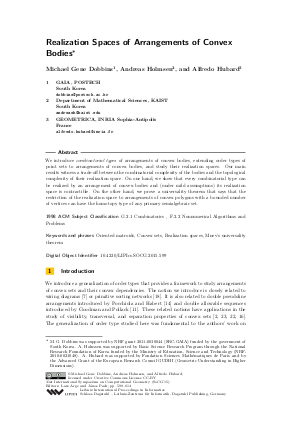Realization Spaces of Arrangements of Convex Bodies
Authors Michael Gene Dobbins, Andreas Holmsen, Alfredo Hubard
-
Part of:
Volume:
31st International Symposium on Computational Geometry (SoCG 2015)
Part of: Series: Leibniz International Proceedings in Informatics (LIPIcs)
Part of: Conference: Symposium on Computational Geometry (SoCG) - License:
 Creative Commons Attribution 3.0 Unported license
Creative Commons Attribution 3.0 Unported license
- Publication Date: 2015-06-12
File

PDF
LIPIcs.SOCG.2015.599.pdf
- Filesize: 0.55 MB
- 16 pages
Document Identifiers
Subject Classification
Keywords
- Oriented matroids
- Convex sets
- Realization spaces
- Mnev’s universality theorem
Metrics
- Access Statistics
-
Total Accesses (updated on a weekly basis)
0PDF Downloads0Metadata Views
Abstract
We introduce combinatorial types of arrangements of convex bodies, extending order types of point sets to arrangements of convex bodies, and study their realization spaces. Our main results witness a trade-off between the combinatorial complexity of the bodies and the topological complexity of their realization space. On one hand, we show that every combinatorial type can be realized by an arrangement of convex bodies and (under mild assumptions) its realization space is contractible. On the other hand, we prove a universality theorem that says that the restriction of the realization space to arrangements of convex polygons with a bounded number of vertices can have the homotopy type of any primary semialgebraic set.
Cite As Get BibTex
Michael Gene Dobbins, Andreas Holmsen, and Alfredo Hubard. Realization Spaces of Arrangements of Convex Bodies. In 31st International Symposium on Computational Geometry (SoCG 2015). Leibniz International Proceedings in Informatics (LIPIcs), Volume 34, pp. 599-614, Schloss Dagstuhl – Leibniz-Zentrum für Informatik (2015)
https://doi.org/10.4230/LIPIcs.SOCG.2015.599
BibTex
@InProceedings{dobbins_et_al:LIPIcs.SOCG.2015.599,
author = {Dobbins, Michael Gene and Holmsen, Andreas and Hubard, Alfredo},
title = {{Realization Spaces of Arrangements of Convex Bodies}},
booktitle = {31st International Symposium on Computational Geometry (SoCG 2015)},
pages = {599--614},
series = {Leibniz International Proceedings in Informatics (LIPIcs)},
ISBN = {978-3-939897-83-5},
ISSN = {1868-8969},
year = {2015},
volume = {34},
editor = {Arge, Lars and Pach, J\'{a}nos},
publisher = {Schloss Dagstuhl -- Leibniz-Zentrum f{\"u}r Informatik},
address = {Dagstuhl, Germany},
URL = {https://drops.dagstuhl.de/entities/document/10.4230/LIPIcs.SOCG.2015.599},
URN = {urn:nbn:de:0030-drops-51020},
doi = {10.4230/LIPIcs.SOCG.2015.599},
annote = {Keywords: Oriented matroids, Convex sets, Realization spaces, Mnev’s universality theorem}
}
Author Details
References
-
Anders Björner, Michel Las Vergnas, Bernd Sturmfels, Neil White, and Günter M. Ziegler. Oriented matroids, volume 46 of Encyclopedia of Mathematics and its Applications. Cambridge University Press, 1999.

-
Raghavan Dhandapani, Jacob E. Goodman, Andreas Holmsen, and Richard Pollack. Interval sequences and the combinatorial encoding of planar families of pairwise disjoint convex sets. Rev. Roum. Math. Pures Appl, 50(5-6):537-553, 2005.

-
Michael Gene Dobbins, Andreas Holmsen, and Alfredo Hubard. Regular systems of paths and families of convex sets in convex position. To appear in Transactions of the AMS.

-
Michael Gene Dobbins, Andreas Holmsen, and Alfredo Hubard. The Erdős-Szekeres problem for non-crossing convex sets. Mathematika, 60(2):463-484, 2014.

-
Stefan Felsner and Pavel Valtr. Coding and counting arrangements of pseudolines. Discrete & Computational Geometry, 46(3):405-416, 2011.

-
Jon Folkman and Jim Lawrence. Oriented matroids. Journal of Combinatorial Theory, Series B, 25(2):199-236, 1978.

-
Jacob E. Goodman. Proof of a conjecture of Burr, Grünbaum, and Sloane. Discrete Mathematics, 32(1):27-35, 1980.

-
Jacob E. Goodman and Richard Pollack. On the combinatorial classification of nondegenerate configurations in the plane. Journal of Combinatorial Theory, Series A, 29(2):220-235, 1980.

-
Jacob E. Goodman and Richard Pollack. Semispaces of configurations, cell complexes of arrangements. Journal of Combinatorial Theory, Series A, 37(3):257-293, 1984.

-
Jacob E. Goodman and Richard Pollack. Upper bounds for configurations and polytopes in ℝ^d. Discrete & Computational Geometry, 1(1):219-227, 1986.

-
Jacob E. Goodman and Richard Pollack. The combinatorial encoding of disjoint convex sets in the plane. Combinatorica, 28(1):69-81, 2008.

-
Helmut Groemer. Geometric applications of Fourier series and spherical harmonics, volume 61 of Encyclopedia of Mathematics and its Applications. Cambridge University Press, 1996.

-
Branko Grünbaum. Arrangements and spreads. American Mathematical Society, 1972.

-
Luc Habert and Michel Pocchiola. Arrangements of double pseudolines. In Proceedings of the 25th Annual Symposium on Computational Geometry, pages 314-323. ACM, 2009.

-
Alfredo Hubard. Erdős-Szekeres para convexos. Bachelor’s thesis, UNAM, 2005.

-
Alfredo Hubard, Luis Montejano, Emiliano Mora, and Andrew Suk. Order types of convex bodies. Order, 28(1):121-130, 2011.

-
Michael Kapovich and John J. Millson. Universality theorems for configuration spaces of planar linkages. Topology, 41(6):1051-1107, 2002.

-
Donald E. Knuth. Axioms and hulls, volume 606 of Lecture Notes in Computer Science. Springer-Verlag, 1992.

-
Friedrich Levi. Die teilung der projektiven ebene durch gerade oder pseudogerade. Ber. Math.-Phys. Kl. Sächs. Akad. Wiss, 78:256-267, 1926.

-
Nicolai E. Mnev. Varieties of combinatorial types of projective configurations and convex polytopes. Doklady Akademii Nauk SSSR, 283(6):1312-1314, 1985.

-
Nicolai E. Mnev. The universality theorems on the classification problem of configuration varieties and convex polytopes varieties. In Topology and Geometry: Rohlin seminar, pages 527-543. Springer, 1988.

-
Mordechai Novick. Allowable interval sequences and line transversals in the plane. Discrete & Computational Geometry, 48(4):1058-1073, 2012.

-
Mordechai Novick. Allowable interval sequences and separating convex sets in the plane. Discrete & Computational Geometry, 47(2):378-392, 2012.

-
János Pach and Géza Tóth. Families of convex sets not representable by points. In Algorithms, architectures and information systems security, volume 3, page 43. World Scientific, 2008.

-
Arnau Padrol and Louis Theran. Delaunay triangulations with disconnected realization spaces. In Proceedings of the 30th Annual Symposium on Computational Geometry, pages 163-170. ACM, 2014.

-
Jürgen Richter-Gebert. Realization spaces of polytopes, volume 1643 of Lecture Notes in Mathematics. Springer Verlag, 1996.

-
Gerhard Ringel. Teilungen der ebene durch geraden oder topologische geraden. Mathematische Zeitschrift, 64(1):79-102, 1956.

-
Peter W. Shor. Stretchability of pseudolines is NP-hard. In Applied Geometry and Discrete Mathematics: The Victor Klee Festschrift, volume 4, pages 531-554. American Mathematical Society, 1991.

-
Yasuyuki Tsukamoto. New examples of oriented matroids with disconnected realization spaces. Discrete & Computational Geometry, 49(2):287-295, 2013.

-
Ravi Vakil. Murphy’s law in algebraic geometry: badly-behaved deformation spaces. Inventiones Mathematicae, 164(3):569-590, 2006.

